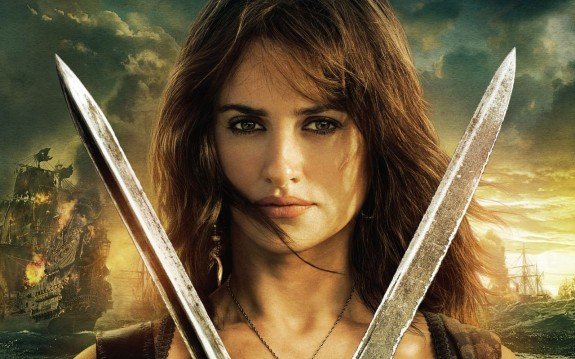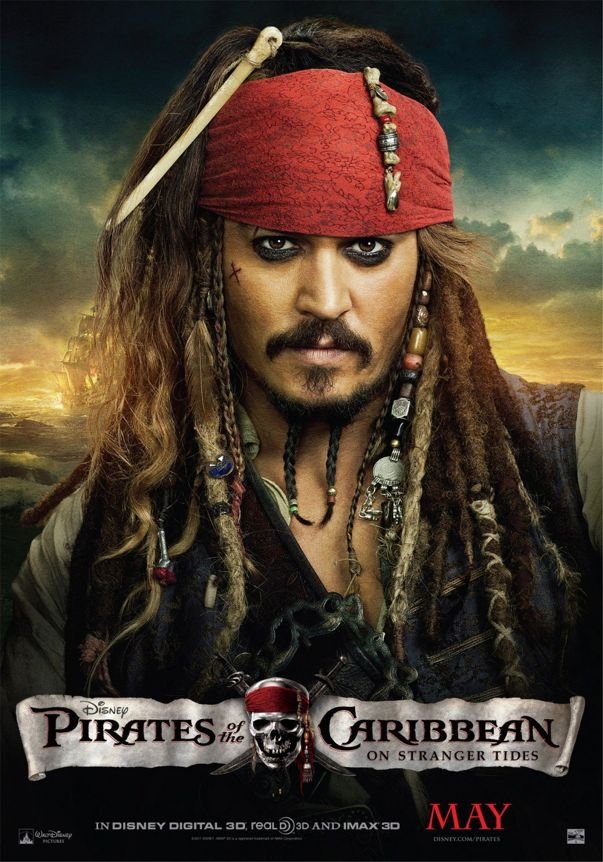Taken for a ride
With the new Pirates of the Caribbean out in theaters, it's clear the movie-theme park synergy is conquering our entertainment dollar
 In search of movie plots, Hollywood has mined books, plays, TV shows, mythology, epic poems, even religious texts. Today, cinematic narrative is unearthed in other, less traditional places --- comic books, video games, cartoons, toy and theme parks rides.
In search of movie plots, Hollywood has mined books, plays, TV shows, mythology, epic poems, even religious texts. Today, cinematic narrative is unearthed in other, less traditional places --- comic books, video games, cartoons, toy and theme parks rides.
Take "Pirates of the Caribbean: On Stranger Tides," which opens Friday, the fourth film in the multi-billion-dollar franchise based on the 1967 Disneyland attraction featuring "Avast, mateys!" pirate talk, skeletons at the ship's wheel, and buccaneers chasing wenches.
Why keep making feature-length adventures inspired by what are essentially elaborate, 10-minute log rides? Is Hollywood that desperate for ideas? Are audiences that unadventurous?To make money? Perhaps. Intellectual property owners do want to make money. The "Pirates" ride at Disney is a beloved institution, with name recognition. Well-executed as a movie series, the Johnny Depp juggernaut have conquered the box office, spawned spin-off novels, picture books, action figures, and video games.
But there are other forces at work here.
Newer generations of genre fans don't want merely to absorb narratives on the big screen. They want to participate in fictional worlds. Multi-platform, movie/book/video game tie-in products are built to sate this desire to experience the narrative outside the movie theater, to interact more directly with the storyline, or to help create a narrative --- whether by playing an video game, writing fan fiction or collecting tchotchkes or other fandom activities.
Movie-inspired amusement park attractions complete the cycle. Take your pick from dozens: Peter Pan to 20,000 Leagues Under the Sea to Mr. Toad's Wild Ride (all based on Disney movie adaptations of classic books); Shrek to E.T. to Men in Black; Revenge of the Mummy, Jaws, to Jurassic Park. The Star Tours motion simulator attraction (now closed at US Disney parks for an upgrade and open only at Tokyo Disneyland) takes place in the "Star Wars" film universe. Warner Bros. Movie World (in Australia) has attractions based on "Batman," "Austin Powers," "Scooby Doo" and Marilyn Monroe. At Thorpe Park (in Britain), there's Saw, the world's first roller coaster based on a horror film. We've come a long way since the first roller coasters began appearing in15th century Russia.
So far, only the Walt Disney Company has the pop-cultural relevance and gravitas to get away with basing a movie on an amusement park attraction. That said, few of these adaptations have raked in pirate-like booty. Take "The Country Bears" (2002), based on the Country Bear Jamboree, both critically derided and a $35 million box office dud. Performing better was Brian DePalma's "Mission to Mars" (2000), partially inspired by the old attraction of the same name that was discontinued in the early 1990s; the EPCOT ride Mission: Space was built after the film came out and houses several of the movie props plus the rotating "gravity wheel" set. "The Haunted Mansion" (2003) also did somewhat better. ("Tower of Terror" (1997), based on the Disney-MGM Studios ride, was a made for TV movie.)
 What's clear is that amusement parks have always been associated with deviance. Ever since the carnival came to town, so have carnies, serial killers, and torrid summer romances with strangers. In "Rollercoaster" (1977) --- released in Sensurround, an effect that vibrated theater seats with huge bass speakers --- Timothy Bottoms's plot to blow up a roller coaster is thwarted by ride inspector George Segal. Then here's the creepy side to those "It's a Small World" robots. In the dreadful "Kiss Meets the Phantom of the Park" (1978), the '70s rock band, in full makeup, battles an evil engineer turning park-goers into mindless cyborgs. In the adult-themed Wild West amusement park of "Westworld" (1973), androids malfunction and start killing the patrons; its sequel, "Futureworld" (1976) concerns a cloning machine and a sci-fi-theme. The "Jurassic Park" movies (1993, 1997, 2001) further fueled fears of mad scientists and technology run amok, and nicely skewered the wholesome, antiseptic Disney park experience.
What's clear is that amusement parks have always been associated with deviance. Ever since the carnival came to town, so have carnies, serial killers, and torrid summer romances with strangers. In "Rollercoaster" (1977) --- released in Sensurround, an effect that vibrated theater seats with huge bass speakers --- Timothy Bottoms's plot to blow up a roller coaster is thwarted by ride inspector George Segal. Then here's the creepy side to those "It's a Small World" robots. In the dreadful "Kiss Meets the Phantom of the Park" (1978), the '70s rock band, in full makeup, battles an evil engineer turning park-goers into mindless cyborgs. In the adult-themed Wild West amusement park of "Westworld" (1973), androids malfunction and start killing the patrons; its sequel, "Futureworld" (1976) concerns a cloning machine and a sci-fi-theme. The "Jurassic Park" movies (1993, 1997, 2001) further fueled fears of mad scientists and technology run amok, and nicely skewered the wholesome, antiseptic Disney park experience.
Of course, theme parks aren't just for cyborgs and dinosaurs; the undead also love them. Two brothers, Jason Patric and Corey Haim, are the new kids in town in "The Lost Boys" (1987), and must confront Kiefer Sutherland and his gang of teenage vampires plaguing an amusement park set on the California coast. In "Zombieland" (2009), zombie apocalypse survivors Woody Harrelson and Jesse Eisenberg hit the road in search of a safe haven, eventually landing in the "Pacific Playland" amusement park, where various rides play a role in the climactic battles.
But not all theme parks are nefarious. "National Lampoon's Vacation" (1983) begins with the lighter theme of summer vacations gone wrong. Chevy Chase drives his family cross-country to the Disney-like Walley World, only to find the park closed for repairs. Which drives Chase crazy, turning him into a BB gun-wielding psychopath. The funny kind. In the 15th James Bond installment, "The Living Daylights" (1987), the Ferris wheel at Vienna's Prater park is where Timothy Dalton scores with one of his Bond girls. In the dramedy "Adventureland" (2009), recent college grad Eisenberg (again) is stuck with a summer job at an amusement park in his hometown (bad), then falls in love (good). At least there are no zombies.
The most lucrative scenario for an entertainment mogul would be to base an entire amusement park on a single franchise. Disney began this by dividing its parks into vague "worlds," like Tomorrowland, Fantasyland, Frontierland, and Adventureland. The "movie studio" parks at Universal and Disney/MGM developed this concept, basing parks around various but mostly unrelated movies ("Jaws," etc). Then Universal's Islands of Adventure created mini-parks devoted to themes like Marvel super heroes, cartoons such as "0Rocky and Bullwinkle," "Jurassic Park"/dinosaurs, ancient myths, and the world of Dr. Seuss. One of these "islands," The Wizarding World of Harry Potter, has blazed a new trail by devoting itself to a single consistent, fictional world. The park opened last year, and features Dragon Challenge, a double roller coaster with intertwining tracks; a more conventional steel roller coaster called Flight of the Hippogriff; and a tour of Hogwarts Castle called Harry Potter and the Forbidden Journey that ends with a broomstick ride past spiders, the Whomping Willow and Dementors. The "set" includes a restaurant, various fake storefronts and real stores where you can purchase merchandise like sugar quills, lemon drops, Bertie Bott's Every-Flavour Beans, and your own broomstick.
It's only a matter of time before entire, giant theme parks are based on the most lucrative franchises in history: Star Wars, Star Trek, The Lord of the Rings, Avatar. But if they build them, will fans come?
In the Boston area, there's an entrepreneur who is hoping that answer is yes. Based at Patriot Place in Foxborough, Matt DuPlessie's company 5 Wits taps into our desire to be part of a movie plot. DuPlessie's walk-through spy adventure Espionage (not affiliated with the James Bond franchise, but definitely inspired by it) opened last fall, and another attraction, 20,000 Leagues, based on Jules Verne's "20,000 Leagues Under the Sea," opened in March. Neither limits users to train car tracks or restricts their motions with seat belts; visitors walk freely through the sets to solve puzzles and, hopefully, save the day.
As the movie-theme park alliance has offered successful synergies, audiences have grown more sophisticated in their taste for special effects. The environments of the original Anaheim and Orlando Disney rides seem primitive by today's standards. Oddly, the quartet of "Pirates of the Caribbean" movies also have very little to do with the ride's original plot, such as it is, which simply evokes generic pirate-themed worlds. To fix this, the old attractions have been retro-fitted and refurbished with better lighting and audio effects. Audio-animatronic figures of Captain Jack Sparrow, his nemesis Barbossa, the squid-faced Davy Jones (all voiced by Depp, Geoffrey Rush, and Bill Nighy respectively) have been added that match the movie world more closely. Of course, the franchise branding had to be updated too; the pirate ship banner and other signage outside the Disney rides now matches the movie poster typeface and other marketing collateral.
While the digital bling of XBox Live, CGI and motion capture may have usurped the power of theme-park attractions, it turns out roller-coaster rides and haunted houses still have their nostalgic tug. They remain an outdated but nonetheless real-world way to participate in cinematic narrative. Taking a ride can still make us feel part of the movie.
As long as the movie is worth the ride.
Recently there's been talk of Jon Favreau ("Iron Man") directing a film based on the entire Disney theme park, Magic Kingdom, but no details yet on what the plot might be. Undead Mickey with assault rifle?
I'd pay to see that.
Ethan Gilsdorf is the author of the award-winning book Fantasy Freaks and Gaming Geeks: An Epic Quest for Reality Among Role Players, Online Gamers, and Other Dwellers of Imaginary Realms, his travel memoir investigation into fantasy and gaming subcultures the Huffington Post called “part personal odyssey, part medieval mid-life crisis, and part wide-ranging survey of all things freaky and geeky," National Public Radio described as "Lord of the Rings meets Jack Kerouac’s On the Road" and Wired.com proclaimed, “For anyone who has ever spent time within imaginary realms, the book will speak volumes.” Follow Ethan's adventures at http://www.fantasyfreaksbook.com.